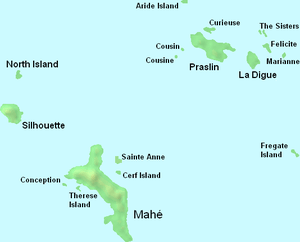Granitic Seychelles
The Granitic Seychelles are the islands in the Seychelles which lie in central position on the Seychelles Bank and are composed of granite rock. They make up the majority of the Inner Islands, which in addition include the coral islands along of the rim of the Seychelles Bank, namely Bird Island and Denis Island. The Granitic Seychelles contrast with the Coralline Seychelles or Outer Islands, several island groups made up of low coral islands with dry, infertile soils.
| Granitic Seychelles Granitic Seychelles forests | |
|---|---|
The small granitic island of Chauve Souris (Praslin) | |
 Map of the Granitic Seychelles | |
| Ecology | |
| Realm | Afrotropical |
| Biome | tropical and subtropical moist broadleaf forests |
| Geography | |
| Area | 166 km2 (64 sq mi) |
| Countries | Seychelles |
| Conservation | |
| Conservation status | Critical/endangered |
| Protected | 38 km² (23%)[1] |
The Granitic Seychelles are home to tropical moist forests, with several endemic species, including the coco de mer (Lodoicea maldivica), and the jellyfish tree (Medusagyne oppositifolia).[2]
Geography
Mahé is the largest and tallest island in the Seychelles, at 145 square km and up to 905 m elevation. There are 42 granitic islands, in descending order of size: Mahé, Praslin, Silhouette, La Digue, Curieuse, Félicité, Frégate, Ste. Anne, North, Cerf, Marianne, Grand Sœur, Thérèse, Aride, Conception, Petite Sœur, Cousin, Cousine, Long, Récif, Round (Praslin), Anonyme, Mamelles, Moyenne, Ile aux Vaches Marines, L'Islette, Beacon (Ile Sèche), Cachée, Cocos, Round (Mahé), L'Ilot Frégate, Booby, Chauve Souris (Mahé), Chauve Souris (Praslin), Ile La Fouche, Hodoul, L'Ilot, Rat, Souris, St. Pierre (Praslin), Zavé, Harrison Rocks (Grand Rocher).
The Granitic Seychelles are fragments of the ancient supercontinent of Gondwana, and have been separated from other continents for 75 million years. The Granitic Seychelles form the northernmost part of the Mascarene Plateau. There are mafic xenolith intrusions in the granite in some areas.
Flora
The native vegetation of these islands consisted of palm, pandanus screw pines, and hardwood forest with mossy, ferny, cloud forest at higher elevations. The flora shows links with both Madagascar to the south and the African mainland to the west. Having been so isolated the islands are rich in endemic plant life including palm trees such as the coco de mer.[2]
Fauna
The unique lizard and reptile populations of the Seychelles include seven species of caecilian and the iconic giant tortoises, Dipsochelys arnoldi on the Granitic Seychelles, and Dipsochelys dussumieri on Aldabra. There have been some extinctions but the remaining endemic birds of these islands include the Seychelles scops owl (Otus insularis) and the Seychelles paradise flycatcher (Terpsiphone corvina).[2]
Threats and preservation
200 years of human settlement has seen the removal of much of the ancient habitat (including planting of coconut, vanilla and cinnamon), and the introduction of damaging invasive species. The Vallée de Mai on Praslin is the largest example of natural palm forest and is a World Heritage Site.
External link
- "Granitic Seychelles forests". Terrestrial Ecoregions. World Wildlife Fund.
References
- Eric Dinerstein, David Olson, et al. (2017). An Ecoregion-Based Approach to Protecting Half the Terrestrial Realm, BioScience, Volume 67, Issue 6, June 2017, Pages 534–545; Supplemental material 2 table S1b.
- "Granitic Seychelles forests". Terrestrial Ecoregions. World Wildlife Fund.